Why? Stay with me. Throughout this article, I’ll share some thoughts around brands, the individuals they partner with, and the audiences they intend to move.
What is a Brand Ambassador?
The day I presented my doctoral dissertation, I carried around a 1970s vanity case. Boxy shape, bright yellow leather, musty smell. I used the case to store everything I’d use to defend my thesis paper that day: documents, pens, markers, clips, and yes, a whole lot of courage. This wasn’t just an ordinary case, it was part of Amelia Earhart’s luggage line for the Baltimore Luggage Company. Let’s stop there for a second: Amelia Earhart, the first woman to successfully complete a trans-Atlantic flight, had collaborated with this luggage brand to launch a collection of travel accessories. A match made in heaven, quite literally.

Earhart brought the aspiration: a woman who had defied the skies and flown towards her dreams in the boldest possible way. The brand, in turn, brought a product: quality leather bags that could join women on inspiring journeys. Together, brand and ambassador partnered to send a coherent, authentic message. A message that resonated with me so deeply that I found myself coveting this product 50 years later.
How did we go from that to … well, 2019?
A Little Brand Ambassador History
Brand communications aren’t what they used to be. In the 60s, an era dominated by Mad Men with lofty New York offices, all you had to do was pick up the phone and purchase space in a newspaper or TV show with high reach. Because media channels were so limited and exclusive, the notion of public trust was significantly different. If you were there, you had somehow made it as a brand. Your message was important, massively distributed, and had less noise to compete with.
Back then, you could also work with a select group of public individuals to position them as the “face of the brand”. That’s how the idea of “brand ambassadors” emerged: if companies could link a celebrity’s positive attributes with those of their products, they could build that lasting association in consumers’ minds and hopefully encourage the purchase decision.
While it’s hard to pinpoint the exact moment in history when this concept developed, we know that the 1940s-1970s were a very active period for brand ambassadorships.
Fast forward to 2019. Print newspapers are struggling to sustain their business models, TV channels are figuring out how to integrate with on-demand streaming services, and the formerly organized field of media promotion is now the very definition of chaos. Reaching your target audience has now become a craft that requires art as much as it does science. In this wild chaos of a marketplace, brands have flocked towards an individual that we commonly denominate the influencer. Ideally, he or she has built a credible platform that brands can leverage to communicate their offerings. So far so good. But here’s where it gets tricky: in a world where influencing itself becomes a business, the very credibility that brands used to benefit from is at stake. And that’s where this concept breaks.
Influencers vs. Brand Ambassadors: Why It Matters
I want to be clear about one thing: this is not an article against individuals that exert influence, this is a call to action for brands. We need to get a lot more intentional about identifying, valuing, and channeling influence in 2019. And that’s where brand ambassadors come in.
On that note, this is also not an “influencers are dead” type of article. In fact, if that’s still the term you prefer to use, by all means, do so. This is not a discussion of form, but a reflection on function. My proposal is not about rejecting the word “influencer”, but about redefining it in terms of the role that best suits your brand’s long term interests. I believe that new meaning is closer to the idea of a Brand Ambassador, and it’s why I’m advocating for its use instead. As a reminder, of sorts, that honest referral can only come from a place of relationship, and genuine influence relies on our ability to convey trust.
In fact, your “influencers” are probably already on board with this idea. According to Activate, long-term partnerships allow these individuals to “shield their audiences from a parade of sponsored collaborations with many different brands.” In turn, your brand can build a long-term relationship on the basis of mutual benefit and transparency. How, exactly? We’ll get into that next.
Why Build a Brand Ambassador Program
Human beings are imperfect. This process is not about finding an impossible person and making him or her your ambassador. This is about structuring a common-sense selection process for the figure that will become, whether you’re aware of this or not, a proxy for your brand.
Put simply, you need a genuine brand advocate, not someone who will jump at your competitor’s next offer. To foster loyalty among your target audience, and truly turn some of their followers into your own, you first need to establish loyalty with the person who is recommending your brand. That relationship projects itself onto this individual’s audience. In the end, it’s a trust chain: followers trust the ambassador, you entrust him/her with your brand message, and ultimately those followers find it easier to trust your brand.
Again, there’s a high chance the “influencers” you currently work with are already on board with this. Mediakix reported that trust is one of the main reasons these individuals decide to work with brands, and ambassadorship offers much more of that than the increasingly popular brand of insta-partnership.
All that said, here are 10 reasons to start building your very own Brand Ambassador program:
- Build long-term relationships. With a structured, intentional brand ambassador program, you get to build a long term relationship with the brand, versus a simple one-off share engagement. The longer your relationship stands, the more opportunities you’ll spot to integrate your product/service to the ambassador’s lifecycle. This individual will be identified with your brand in a series of moments, which can increase the strength of the ambassador-brand association and facilitate unaided brand recall in the future. The long-term payoff is clear.
- Foster deeper value alignment and assimilation. Because you’re selecting someone that will belong to a formal, permanent program, you’re more likely to evaluate their genuine alignment with the brand’s values. In other words, you’re not looking for someone that will merely help distribute a message, but someone that stands for that message and has built the authority to communicate it.
- Recognize and celebrate the individual’s role. An ambassador holds an elevated role within the team that clearly identifies them as purveyors and evangelists of the brand’s message. They exhibit the brand’s values in various areas of their life, not just the one that’s intimately related to the product. In traditional settings, ambassadors represent their “countries” with the utmost respect for their policies, and behave in a manner that speaks positively about national values. The public, longer-term nature of the individual-brand relationship offers buyers and potential buyers a clearer sense of their connection.
- Grow together. When you select the right ambassador and grow alongside them, you are truly cultivating a “sister channel” whose growth you’ll also benefit from. By investing in the partnership, your brand incubates this individual’s venture and empowers him/her to continue reaching greater audiences with your brand by their side. This type of mutualism can help build audiences in emerging markets, where both brand and ambassador face communication challenges at first.
- Facilitate strategic brand education. In the context of an ambassadorship, you can train this individual to understand the technical and strategic traits of the brand. Brand education includes, but is not limited to, sharing voice & tone guidelines, talking points, product information, team values, company history, among many others.
- Co-create with freedom and rapport. Once the ambassador is trained in the inner workings of your brand, you can tap their audience insights to develop new products. It is no longer enough to feed an influencer with a press release, an asset library, or canned marketing messages. You want them in the room for brand development. You want to ask audience questions that they’re uniquely positioned to answer. You want their feedback. You want empowered brand ambassadors that can help you grow this thing.
- Increase credibility. When you develop a more invested relationship with your ambassadors, they’ll familiarize themselves with the brand experience within an environment of commitment and trust. Because you’ve created a safe space for them to learn about you, they’ll express that same sense of trust when speaking about the brand. Credibility can’t be faked. You can’t expect your ambasadors to convey trust when, deep down, they’re not sure about the nature of their relationship with you. It’s a virtuous cycle.
- Engage someone who is a natural fit. Recruiting can happen based on who is already, organically, using the product. This can make brand placements feel more natural and comfortable, both for the ambassador and his/her audience.
- Protect category exclusivity. Opportunity to execute exclusivity contracts that prevent undesirable brand hopping. This situation where a single person is suddenly promoting four different brands in the same space is unsustainable and confusing. It shreds credibility, both the influencer’s and the promoted brand’s.
- Fuel innovation. With a longer-term ambassadorship, you can provide more margin time and resources for the influencer to apply his/her creative freedom. Making a living as a content creator is no easy feat, so if you can provide fair compensation for their time, you’ll be creating the right context for your ambassador’s creativity, and loyalty to the brand, to thrive.
How to Build Your Brand Ambassador Program
If you’ve decided a Brand Ambassador program is the right fit for your company, follow these simple steps:
1. Set clear goals. Lewis Carroll once said that if you “don’t know where you are going, any road will get you there”. Set attainable, yet ambitious goals that set the tone for all the work you’ll do with your new ambassador/s. You might want to increase your total reach, have a steadier flow of user-generated content to republish, or establish a new channel to facilitate product launches. If the ambassador you’re considering speaks to an audience that isn’t familiar with your brand yet, one of your goals might also be around new market penetration or brand repositioning.
2. Research viable candidates. In order to exert the right type of influence and deliver your message genuinely, what should this individual be like? What should they do on a day to day basis? How is their lifestyle structured? Which life stage are they in? Where do they live? The more detailed your ambassador profile gets, the easier it’ll be to vet the right candidates from the start. Come up with a list of non-negotiable and desirable traits and let that guide your research efforts.
Some online platforms are making this research stage incredibly easier. Check out Activate or Influenster‘s databases to explore suitable candidates. You can also run an independent search in the platform where you’re most interested in expanding, through the ambassador’s work. If your main interest is around Instagram, for example, search for individuals that have built an engaged audience in that channel.
3. Promote your program. You might want to open applications to a wider net. In that case, prepare promotional material to encourage candidates to apply. Have an online application form ready for those who are interested in joining. Some questions you may want to ask include:
- Details about the potential ambassador’s communication platform: what kind of consumer follows them?
- Size-wise, how would they define the community they reach?
- Examples of previous campaigns where they’ve collaborated with brands
- Media/press kit attachments. Some content creators will have standard media kits that are ready to share with brands.
Some brands take this up a notch and create specialized landing pages to cater to these individuals. Here is a great example from Printful:
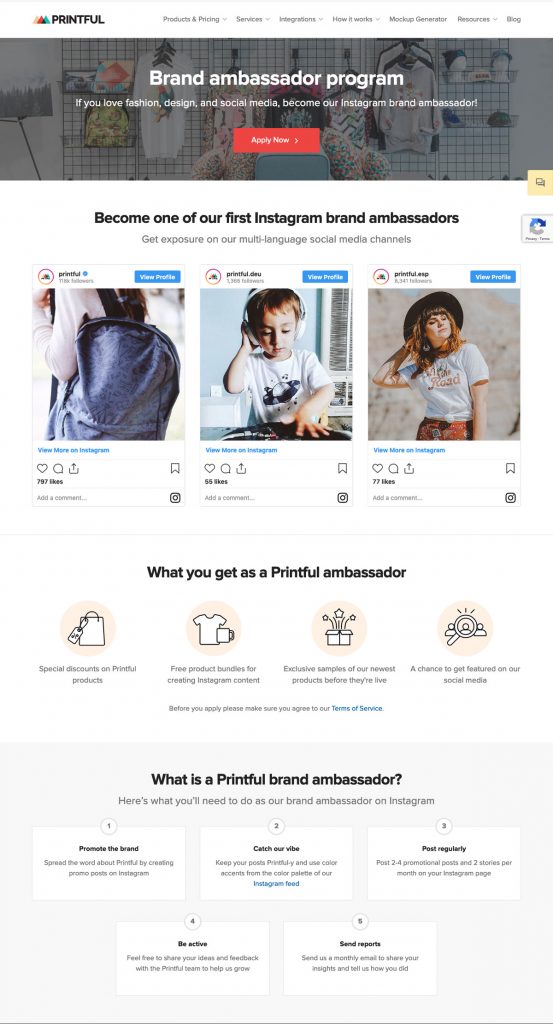
4. Reach out. If someone who has applied or you’ve identified seems interesting enough to pursue, reach out to assess their interest. Email them presenting the opportunity and some of the most appealing perks of the program, as well as basic expectations. If they express their interest, it’s time for step 5!
5. Engage them and formalize the relationship. Clarity and trust are essential in the brand-ambassador relationship. Prepare a contract that these individuals can sign, agreeing to abide by certain terms and complete specific tasks. Along with the contract, send them an onboarding document including the following content:
-
- Welcome letter. ideally from the CEO or Ambassador Program Manager
- Responsibilities. What does a brand ambassador at (company name) do?
- Compensation and perks. What are the benefits of joining your program? Brands often offer cash compensation, free products, exclusive event invitations, audience discounts, insider access, among many other advantages that allow these ambassadors to promote the brand to the best of their ability.
- Specific policies and terms. Ambassadors will want to know the legal details of their engagement, what the expectations are, and how the agreement could be terminated by either party. Printful has also published a robust set of terms and conditions for its ambassador program. If you want to collect their signature electronically, Jotform offers that feature as well as a library of contract templates where you’ll find ambassador-specific text to use.
6. Track success. Stay on top of the goals you set in step 1 by making sure they all have a measurable indicator you can monitor over time. Looking to expand reach? Consider total impressions or specific pageviews as key metrics to track. If ambassadors help you generate awareness around product launch events, measure their attendance. Make sure the program is developing in alignment with your business objectives.
Some inspiring brand ambassador program examples
When you’re starting from scratch, it can be helpful to analyze how other brands are setting up and promoting their own programs. Here are some outstanding examples:
Lululemon
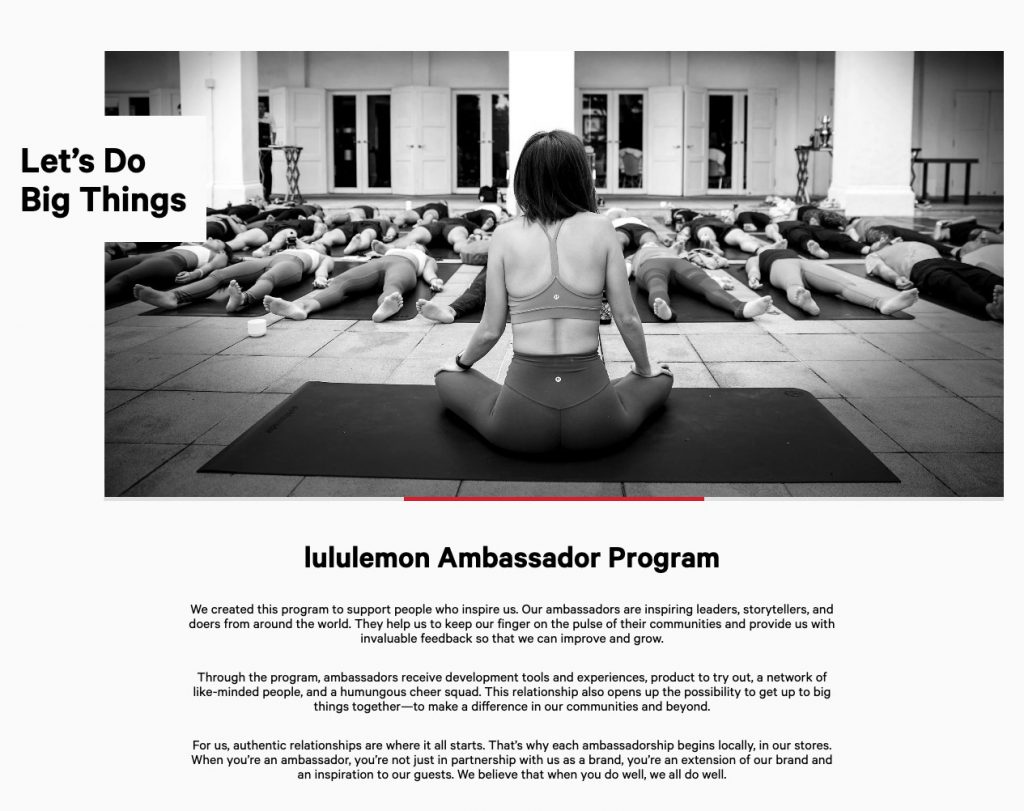
Pura Vida Bracelets
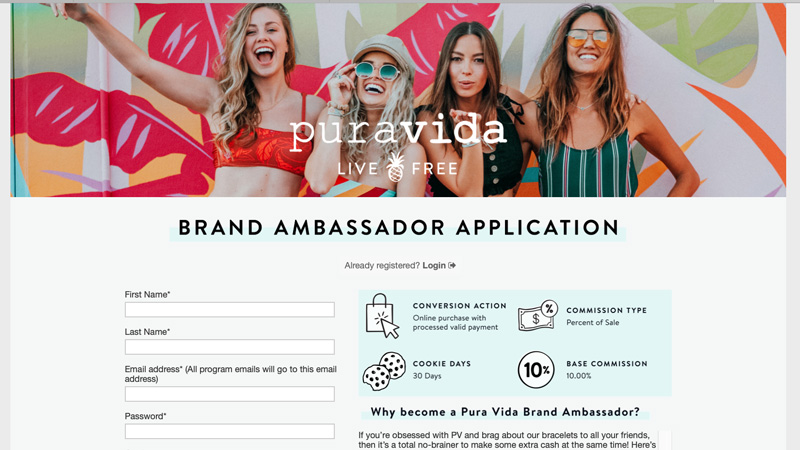
Rosefield
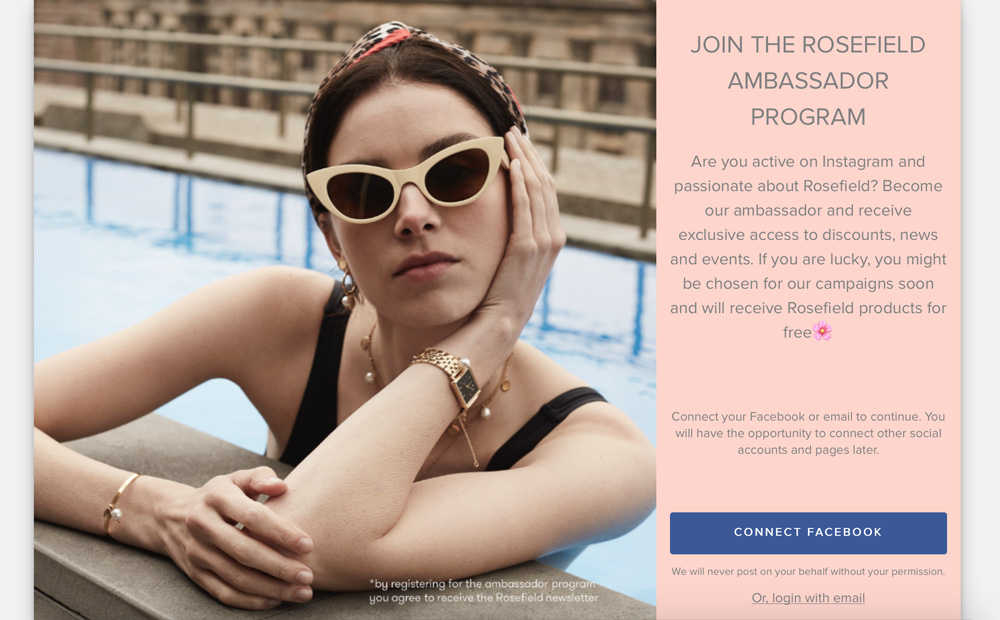
World Wildlife Fund
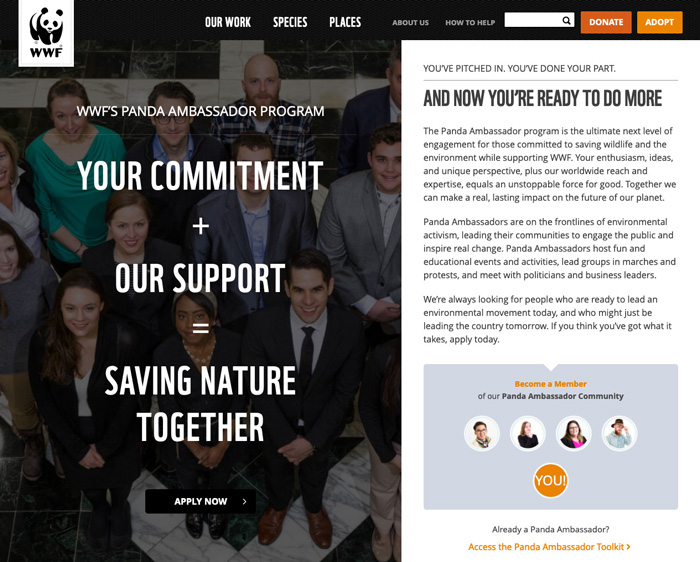
Your turn
Have you seen any interesting ambassador programs recently? Share them in the comments section below, as well as any questions you have about this topic. Happy to help you find the answer!
